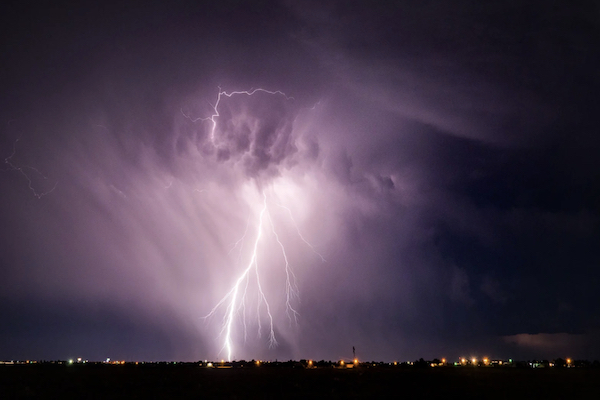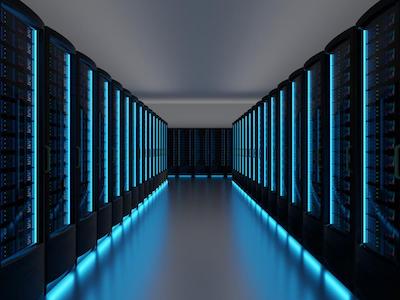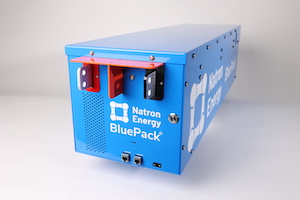The Right Battery Can Avert Catastrophe
As temperatures lurch up and down, storms rage, and wildfires burn, the aging United States power grid remains vulnerable. Outages caused by extreme weather cascade across industries, costing the U.S. billions each year.
In this environment, the data center industry is susceptible to catastrophic storage meltdowns. Backup power from lead-acid and lithium-ion batteries counter sustainability efforts. Worse, the battery technologies can contribute to the meltdown with failures or fires. Sodium-ion battery technology is a more sustainable, and inherently safe solution for data centers and any mission-critical business.

Traditional batteries can compound problems
The many possible causes of a data center outage include hardware failure, software bugs, cybercrime, and natural disasters. The resulting downtime and data losses are always devastating.
Preventing these meltdowns requires robust and reliable backup power. Without it, servers and associated IT systems can shut down improperly, corrupting or losing data, damaging hardware, or simply disrupting the network. Data centers are always equipped with uninterruptible power supply (UPS) systems that smooth fluctuations in incoming grid power, and support the data center load for a short time in the event of a power outage – until backup generators kick in.
Lead-acid batteries have been the traditional choice to power these UPS systems. This meant sophisticated, sleek, modern data centers were relying on stacks of bulky, heavy, often unreliable car batteries. Lead-acid batteries also pose a risk of overheating when overcharged or discharged too rapidly, a necessary function of a UPS system. Hydrogen gas can build up and ignite, causing an explosion, and corrosive sulfuric acid can leak out if lead-acid batteries are damaged or cracked. Not an ideal environmental or safety choice.
Lithium-ion batteries for UPS systems improved upon some of lead-acid’s problems, but the tradeoff was a high risk of fire. Lithium-ion batteries are far more prone to catastrophic failure than lead-acid batteries; they can be induced to thermal runaway more easily. When these batteries overheat and catch fire or explode, they can cause severe damage to the storage devices, as well as potential loss of data (not to mention harming humans near the site). Thermal runaway can be caused by overcharging, physical damage, exposure to high temperatures or humidity, and manufacturing defects.

Lithium-ion batteries are believed to have contributed to many data center meltdowns in the last five years, including Saint-Trivier-sur-Moignans and Strasbourg in France, and another in South Korea. Complicating matters further, the fire risk associated with lithium-ion batteries led to understandable – yet, still onerous – regulations around the storage and transport of these batteries. It’s no surprise that many data center operators have been slow to embrace lithium-ion batteries. When uptime is everything, the risk with lithium-ion is just too great.
Sodium-Ion batteries eliminate the risk of catastrophic meltdowns
Sodium-ion batteries are a safer, more sustainable alternative to traditional batteries. Not only are they made of abundant raw materials that require no conflict minerals, but they also are four to five times more power-dense than lithium-ion or lead-acid batteries, and far safer.
Electrode chemistries, like Prussian blue, take a man-made dye and turn it into a completely safe, porous energy storage medium. These pores allow immediate discharge and full recharge in under a quarter-hour. This reduces the wear on backup generators and, more importantly, their carbon emissions, since the sodium-ion battery will be charged and prepared for back-to-back power events faster. Their chemistry allows sodium-ion batteries to perform this rapid discharge/recharge cycle tens of thousands of times before replacement is needed. Thanks to their long service life, and because they minimize the role of the generator, sodium-ion batteries can help data centers move toward their environmental and social governance (ESG) goals.
 Where sodium-ion batteries really stand out is safety. Sodium-ion batteries are safe, nonhazardous, and cannot be induced to thermal runaway. They will not catch fire or explode, even if exposed to direct flame or punctured. This is a massive risk reduction for data centers. Sodium-ion batteries perform equal to or better than traditional alternatives by every measure, and entirely without risk of fire or explosion. These batteries can be shipped fully charged by ground or air (unthinkable for lead-acid or lithium-ion) thereby accelerating system start-up.
Where sodium-ion batteries really stand out is safety. Sodium-ion batteries are safe, nonhazardous, and cannot be induced to thermal runaway. They will not catch fire or explode, even if exposed to direct flame or punctured. This is a massive risk reduction for data centers. Sodium-ion batteries perform equal to or better than traditional alternatives by every measure, and entirely without risk of fire or explosion. These batteries can be shipped fully charged by ground or air (unthinkable for lead-acid or lithium-ion) thereby accelerating system start-up.
The major takeaways for data centers, especially as they deal with increasingly extreme and frequent weather events include:
- Able to handle temperature swings – Sodium-ion batteries can operate in a wide range of temperatures (-58°F to 122°F) and will not be induced to thermal runaway by operating in very high or low temperatures.
- Safer, super-fast discharge – Sodium-ion batteries can immediately discharge without risk of overheating, and without settling or thermal waiting.
- Will not worsen a meltdown – If the worst should happen (i.e., a data center floods or experiences a fire) sodium-ion batteries will keep working as long as they can. They will not immediately shut down, nor will they ever catch fire or explode.
- Lighter overall footprint – Measuring the total cost of ownership, sodium-ion batteries provide excellent value, and contribute significantly to ESG goals. They require replacement less often, are made from sustainable, non-conflict materials, and reduce emissions from generators.
Data centers can no longer avoid extreme weather and the associated outages and catastrophic meltdowns by choosing a “safe” geographical location. Their operators should plan for weather-related outages as a “when,” not an “if.” Sodium-ion batteries can power UPS systems better than traditional battery technologies, removing the major risks of lithium-ion and lead-acid. They are the safer solution.
 Jack Pouchet is the Vice President of Sales and Marketing for Natron Energy. Jack works closely with major OEMs, large Telecom, and data center owners and operators, BESS/ESS integrators, industrial power users driving towards decarbonization, and leading mission-critical engineering firms to help define, architect, and create opportunities for advanced battery and power technologies that improve day-to-day business and operational efficiencies. Jack brings over twenty years of related OEM power supply, power generation, distribution, and power product sales and marketing experience to Natron, giving him a unique, end-to-end perspective of the entire AC and DC power path.
Jack Pouchet is the Vice President of Sales and Marketing for Natron Energy. Jack works closely with major OEMs, large Telecom, and data center owners and operators, BESS/ESS integrators, industrial power users driving towards decarbonization, and leading mission-critical engineering firms to help define, architect, and create opportunities for advanced battery and power technologies that improve day-to-day business and operational efficiencies. Jack brings over twenty years of related OEM power supply, power generation, distribution, and power product sales and marketing experience to Natron, giving him a unique, end-to-end perspective of the entire AC and DC power path.
Natron | natron.energy
Author: Jack Pouchet
Volume: 2023 May/June









